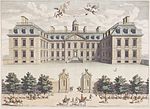Albemarle Club
1874 establishments in EnglandBuildings and structures in MayfairDefunct clubs and societies of the United KingdomHistory of the City of Westminster
The Albemarle Club was a private members' club at 13 Albemarle Street, London, founded in 1874 and open to both men and women. It closed in 1941.
Excerpt from the Wikipedia article Albemarle Club (License: CC BY-SA 3.0, Authors).Albemarle Club
Albemarle Street, City of Westminster Mayfair
Geographical coordinates (GPS) Address Website Nearby Places Show on map
Geographical coordinates (GPS)
| Latitude | Longitude |
|---|---|
| N 51.509111111111 ° | E -0.14191666666667 ° |
Address
Stalwart Cleaning
Albemarle Street 14
W1S 4HL City of Westminster, Mayfair
England, United Kingdom
Open on Google Maps








